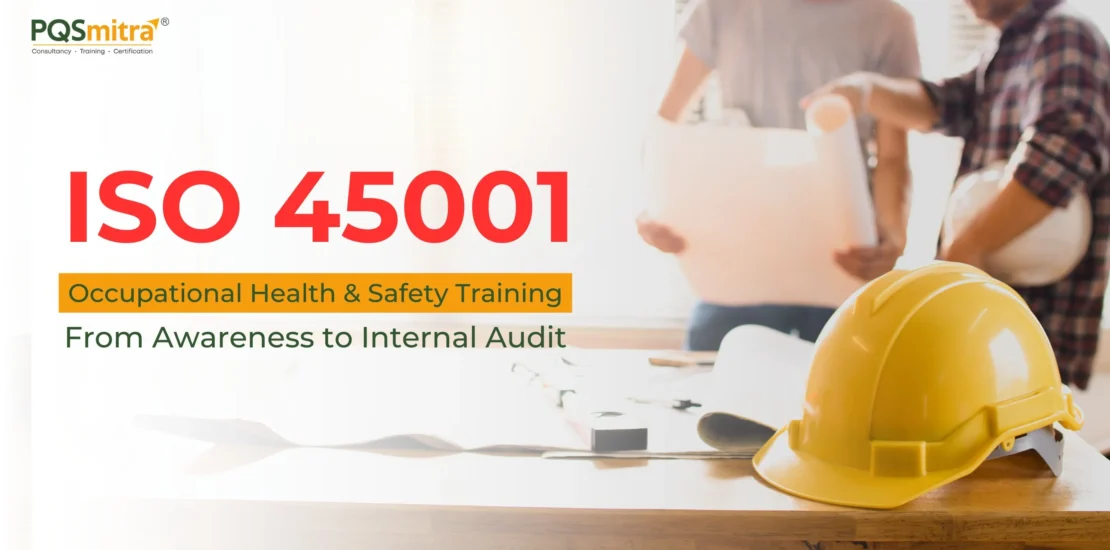- November 24, 2024
- Posted by: PQS_Mitra_Main_Access
- Category: ISO Certification

Introduction
Every workplace carries some degree of risk—whether it’s an office with ergonomic concerns or a manufacturing floor with hazardous machinery. Organizations that prioritize employee well-being don’t just comply with regulations—they build trust, improve morale, and reduce business disruptions.
This is where ISO 45001, the international standard for Occupational Health & Safety Management Systems (OH&SMS), comes into play. It provides a systematic approach to identifying and controlling health and safety risks, reducing potential incidents, and improving overall workplace safety.
However, having a system in place isn’t enough. To make it effective, everyone involved must understand how it works—and why it matters.
Beyond Compliance: Why Safety Culture Starts with Understanding
Often, companies approach health and safety as a regulatory requirement, focusing on documentation and inspections. But real workplace safety goes deeper—it requires a culture where safety is a shared responsibility.
ISO 45001 emphasizes:
- Proactive risk identification and control
- Worker involvement in decision-making
- Leadership commitment and accountability
- Integration of safety with core business strategy
- Continual improvement based on performance data
These aren’t box-ticking exercises—they’re fundamental shifts in mindset. And to embed them into daily work, organizations must start with awareness.
The Gaps That Appear Without Awareness
Even in well-documented systems, the root cause of incidents is often a lack of clarity or ownership. Common questions that surface during audits and incidents include:
- “Who’s responsible for reporting near misses?”
- “What are the actual health and safety objectives?”
- “How do we ensure contractors follow our OH&S policies?”
- “Why do we need to update risk assessments regularly?”
These gaps highlight the importance of organization-wide understanding. ISO 45001 cannot live in documents—it needs to be understood on the floor, in the field, and in leadership discussions.
Why Organizations Must Invest in Safety Awareness
Awareness is the foundation for a strong safety culture. Before a single audit checklist is filled or a non-conformance is addressed, employees must first understand what ISO 45001 is about and how it applies to their role.
For example:
- A supervisor needs to know how to conduct a hazard analysis
- An HR manager should understand the impact of safety training records
- A worker must be confident in their right to stop unsafe work
- A contractor needs clear expectations on PPE and reporting
Awareness training ensures that the entire ecosystem is aligned on goals, responsibilities, and processes—minimizing the risk of injury and improving audit readiness.
Structured Training Enables Proactive Safety Management
Once awareness is established, the next step in strengthening OH&S systems is training internal auditors. Internal audits are not just for certification—they are critical tools for early detection of issues and continual improvement.
Internal auditor training under ISO 45001 focuses on:
- Interpreting the ISO 45001 standard clauses
- Planning and conducting audits objectively
- Identifying and documenting nonconformities
- Evaluating risk and compliance to legal and other requirements
- Driving improvements and corrective actions through findings
When internal auditors are well-trained, audits become more than routine checks—they become strategic inputs for organizational safety enhancement.
Training Supports Long-Term System Success
A successful ISO 45001 implementation isn’t a one-time project—it’s a continuous cycle. And training plays a key role in sustaining that cycle. Through ongoing training sessions, organizations can:
- Refresh awareness for new hires and teams
- Address updates in legal and industry safety requirements
- Improve employee engagement in safety initiatives
- Develop internal audit capability to support self-monitoring
+Whether you’re implementing ISO 45001 for the first time or strengthening an existing system, structured training ensures that safety becomes part of the organization’s DNA.
Conclusion
Safety isn’t something you achieve once and forget. It requires ongoing attention, learning, and improvement. ISO 45001 provides the roadmap, but it’s awareness and internal audit capability that keep the system moving forward.
Organizations that invest in training don’t just reduce risk—they build a workplace where people feel valued and protected. And in doing so, they ensure continuity, compliance, and confidence.
PQSmitra offers both awareness and internal auditor training programs for ISO 45001, delivered onsite or online, with certification. These trainings are designed to help organizations embed safety at every level—making health and safety not just a policy, but a practice.
Leave a Reply Cancel reply
Kindly submit a business inquiry online and we will get back to you!
OR
Call us on 022-2893 8687 | +91-9820204373
